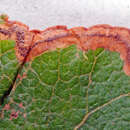zh-TW
在導航的名稱


Stigmella trimaculella is a moth of the family Nepticulidae. It is found in most of Europe, east to the eastern part of Palearctic realm.
The wingspan is 5–6 millimetres (0.20–0.24 in). The thick erect hairs on the head vertex are ochreous-yellowish. The collar is white. Antennal eyecaps are whitish. The forewings are dark fuscous; a broad median longitudinal patch extending from base to near middle, and large opposite sometimes confluent triangular costal and dorsal spots beyond middle whitish-yellowish. Hindwings are grey. Abdomen of male yellowish, crimson-tinged.[1] External image
Adults are on wing in May and again in August.[2]
The larvae feed on Populus alba, Populus angustifolia, Populus x canadensis, Populus candicans, Populus canescens, Populus deltoides, Populus nigra, Populus simonii, Populus suaveolens, Populus tremula and Populus trichocarpa. They mine the leaves of their host plant. The mine consists of a corridor. The first part of the mine is straight and narrow, and often follows a vein. The frass is concentrated in a nearly uninterrupted central line that does not occupy the full width of the gallery . The second part is considerably broader, sometimes almost resembling a blotch. The frass pattern here is very variable, ranging from a narrow central line to a broad band.[3]
Stigmella trimaculella is a moth of the family Nepticulidae. It is found in most of Europe, east to the eastern part of Palearctic realm.
 Stigmella trimaculella mine
Stigmella trimaculella mine The wingspan is 5–6 millimetres (0.20–0.24 in). The thick erect hairs on the head vertex are ochreous-yellowish. The collar is white. Antennal eyecaps are whitish. The forewings are dark fuscous; a broad median longitudinal patch extending from base to near middle, and large opposite sometimes confluent triangular costal and dorsal spots beyond middle whitish-yellowish. Hindwings are grey. Abdomen of male yellowish, crimson-tinged. External image
Adults are on wing in May and again in August.
The larvae feed on Populus alba, Populus angustifolia, Populus x canadensis, Populus candicans, Populus canescens, Populus deltoides, Populus nigra, Populus simonii, Populus suaveolens, Populus tremula and Populus trichocarpa. They mine the leaves of their host plant. The mine consists of a corridor. The first part of the mine is straight and narrow, and often follows a vein. The frass is concentrated in a nearly uninterrupted central line that does not occupy the full width of the gallery . The second part is considerably broader, sometimes almost resembling a blotch. The frass pattern here is very variable, ranging from a narrow central line to a broad band.
De populierenmineermot (Stigmella trimaculella) is een vlinder uit de familie dwergmineermotten (Nepticulidae). De wetenschappelijke naam is voor het eerst geldig gepubliceerd in 1828 door Haworth.
De soort komt voor in Europa.
Bronnen, noten en/of referenties
Stigmella trimaculella er en sommerfugl som tilhører familien dvergmøll (Nepticulidae). Den har larver som minerer i bladene på poppel-arter. Den er funnet på noen få lokaliteter i det sørligste Norge.
En liten (vingespenn 5-6 millimeter), brokete møll. Denne kontrastrikt fargede arten er en av relativt få dvergmøll som lar seg bestemme bare ut frå ytre utseende. Hodet er kledt med gulbrune eller lysbrune, hårlignende skjell, det forstørrede, første antenneleddet, kragen og "skuldrene" er hvite. Forkroppen og forvingens bunnfarge er mørkebrune. Bakkroppen og bakbeina hos hannen er oransjerøde, hos hunnen gråbrune. Forvingen har varierende, hvite tegninger som typisk består av en hvit flekk ved roten og hvite flekker ved for- og bakkanten litt utenfor midten av vingen – hos noen individer er de tre hvite flekkene vokst sammen. Larven er lyst grønngul.
Larvene lever på ulike poppel-arter (Populus spp.), der den gnager en mine i bladet. Arten har to generasjoner hvert år, de voksne flyr i juni og august. Arten finnes i alleer, parker og andre steder der poppel-arter er plantet.
Arten er utbredt i det nordlige og østlige Europa østover til området ved Volga. I Norge er den bare funnet i Østfold og Vest-Agder.
Stigmella trimaculella er en sommerfugl som tilhører familien dvergmøll (Nepticulidae). Den har larver som minerer i bladene på poppel-arter. Den er funnet på noen få lokaliteter i det sørligste Norge.
Stigmella trimaculella é uma espécie de insetos lepidópteros, mais especificamente de traças, pertencente à família Nepticulidae.[1]
A autoridade científica da espécie é Haworth, tendo sido descrita no ano de 1828.
Trata-se de uma espécie presente no território português.
Stigmella trimaculella é uma espécie de insetos lepidópteros, mais especificamente de traças, pertencente à família Nepticulidae.
A autoridade científica da espécie é Haworth, tendo sido descrita no ano de 1828.
Trata-se de uma espécie presente no território português.
Stigmella trimaculella là một loài bướm đêm thuộc họ Nepticulidae. Nó được tìm thấy ở hầu hết Europe, phía đông đến phần phía đông của Palearctic ecozone.
Sải cánh dài 5–6 mm. Con trưởng thành bay vào tháng 5 và một lần nữa vào tháng 8.
Ấu trùng ăn Populus alba, Populus angustifolia, Populus x canadensis, Populus candicans, Populus canescens, Populus deltoides, Populus nigra, Populus simonii, Populus suaveolens, Populus tremula và Populus trichocarpa. Chúng ăn lá nơi chúng làm tổ.
Stigmella trimaculella là một loài bướm đêm thuộc họ Nepticulidae. Nó được tìm thấy ở hầu hết Europe, phía đông đến phần phía đông của Palearctic ecozone.
Sải cánh dài 5–6 mm. Con trưởng thành bay vào tháng 5 và một lần nữa vào tháng 8.
Ấu trùng ăn Populus alba, Populus angustifolia, Populus x canadensis, Populus candicans, Populus canescens, Populus deltoides, Populus nigra, Populus simonii, Populus suaveolens, Populus tremula và Populus trichocarpa. Chúng ăn lá nơi chúng làm tổ.